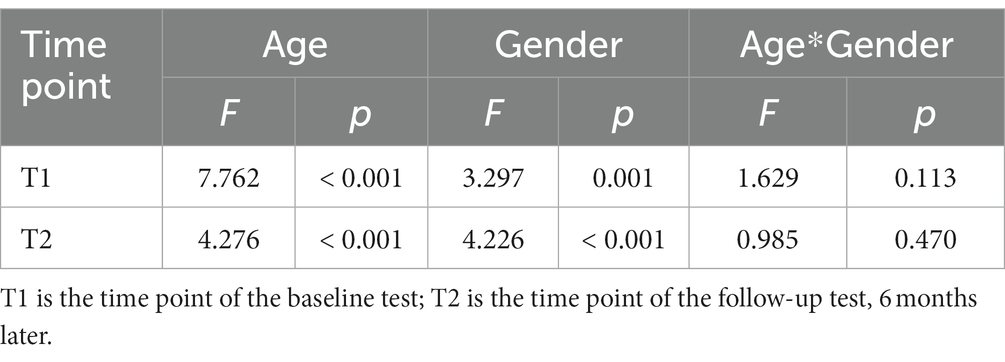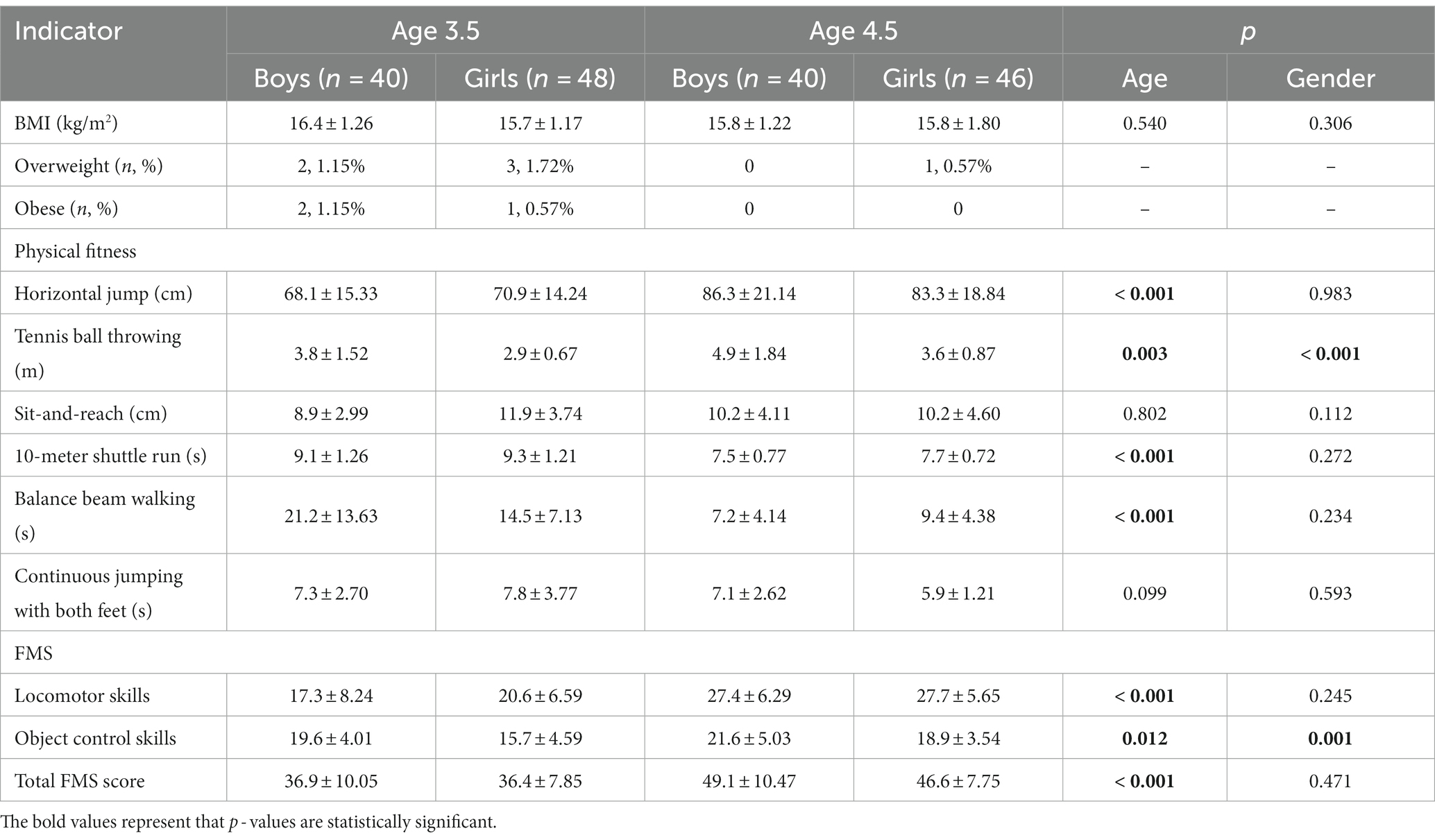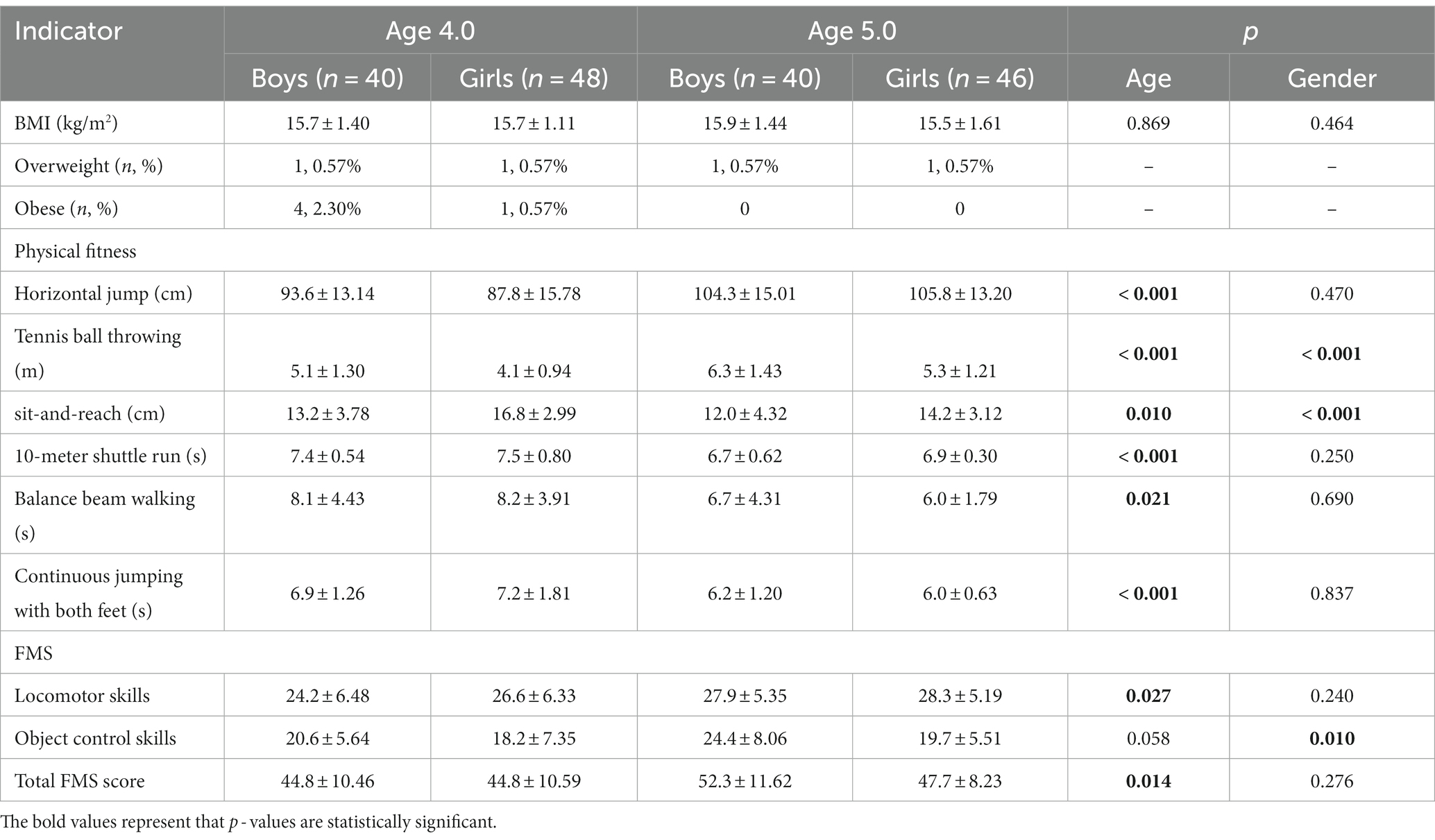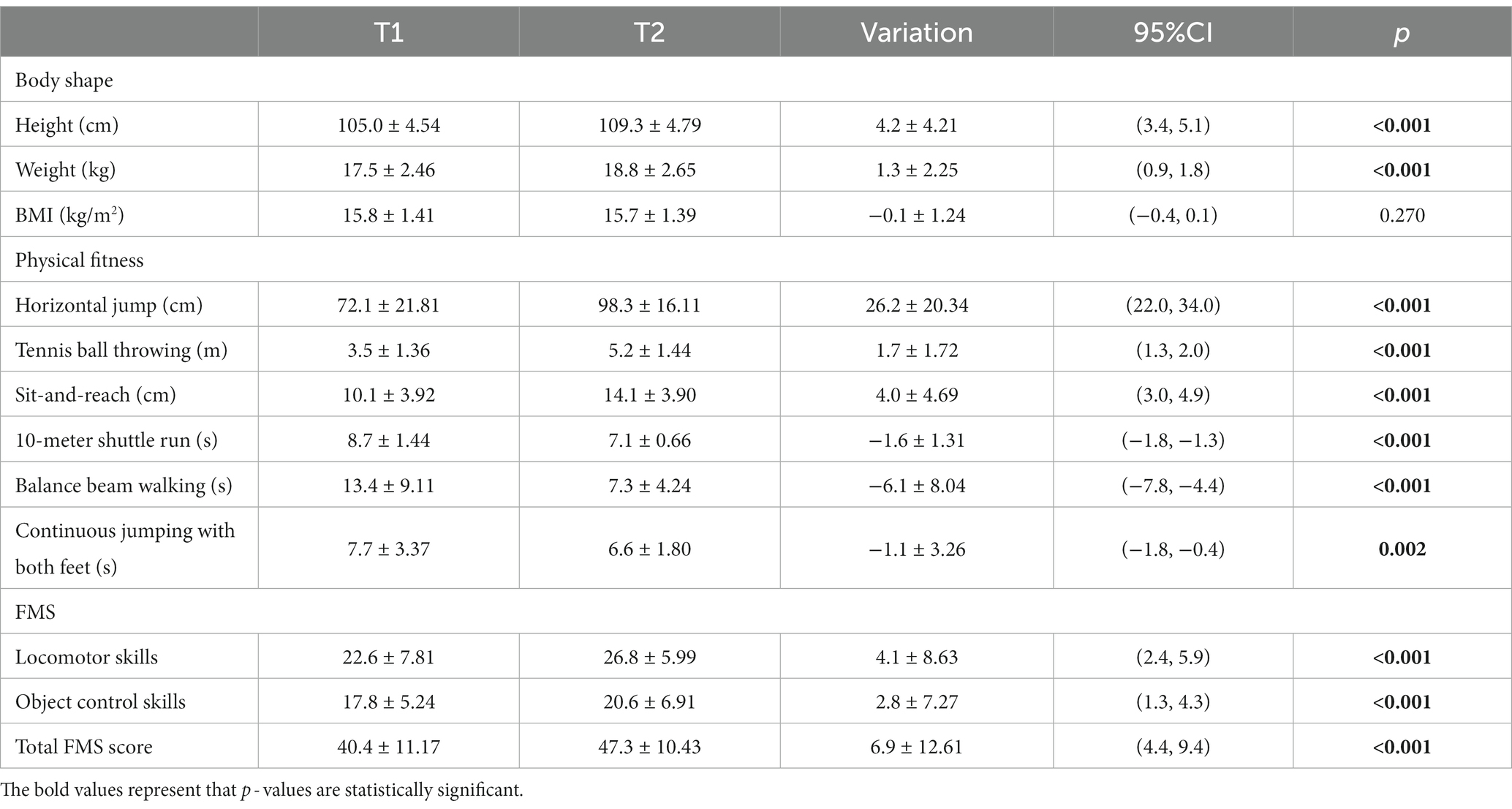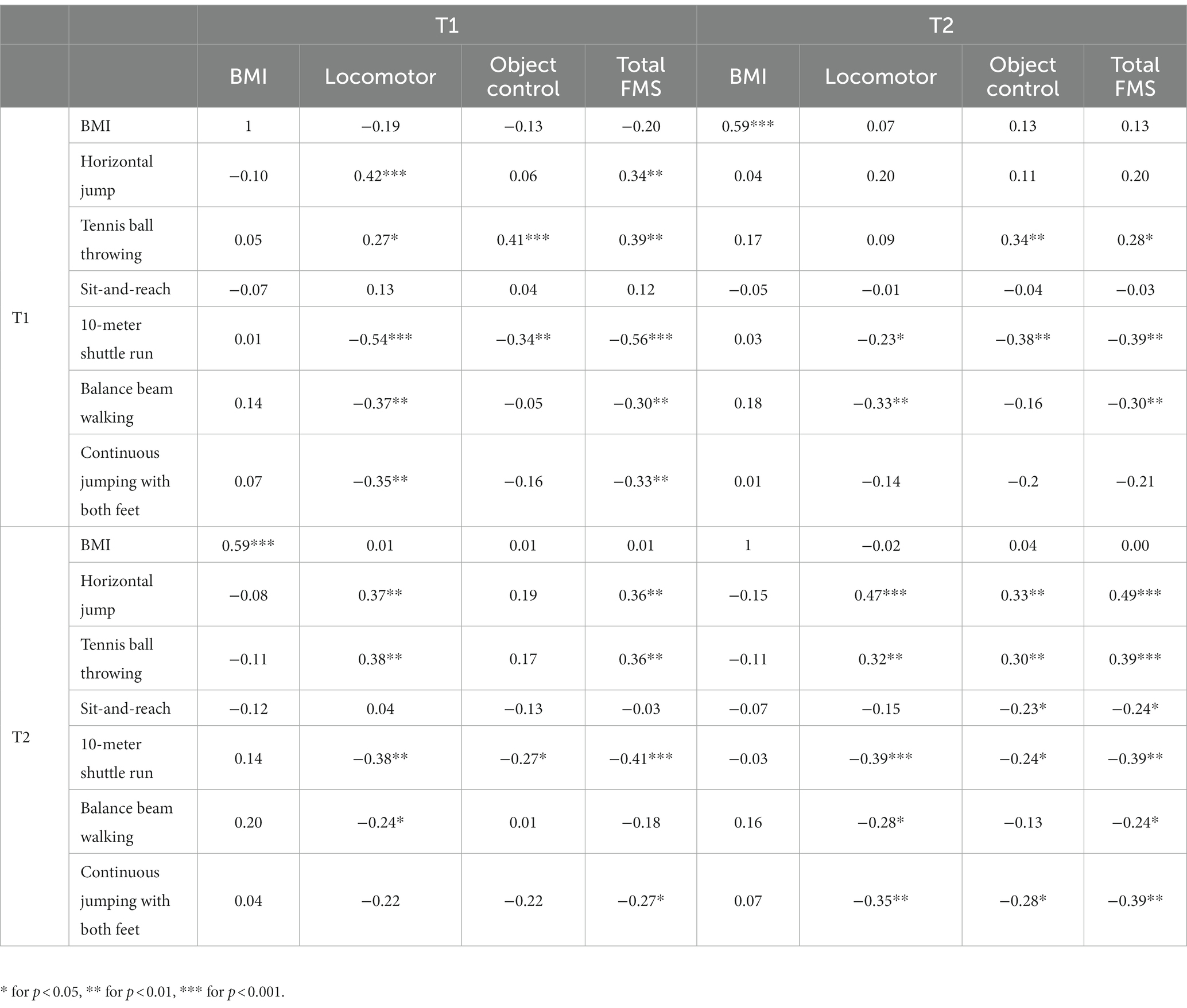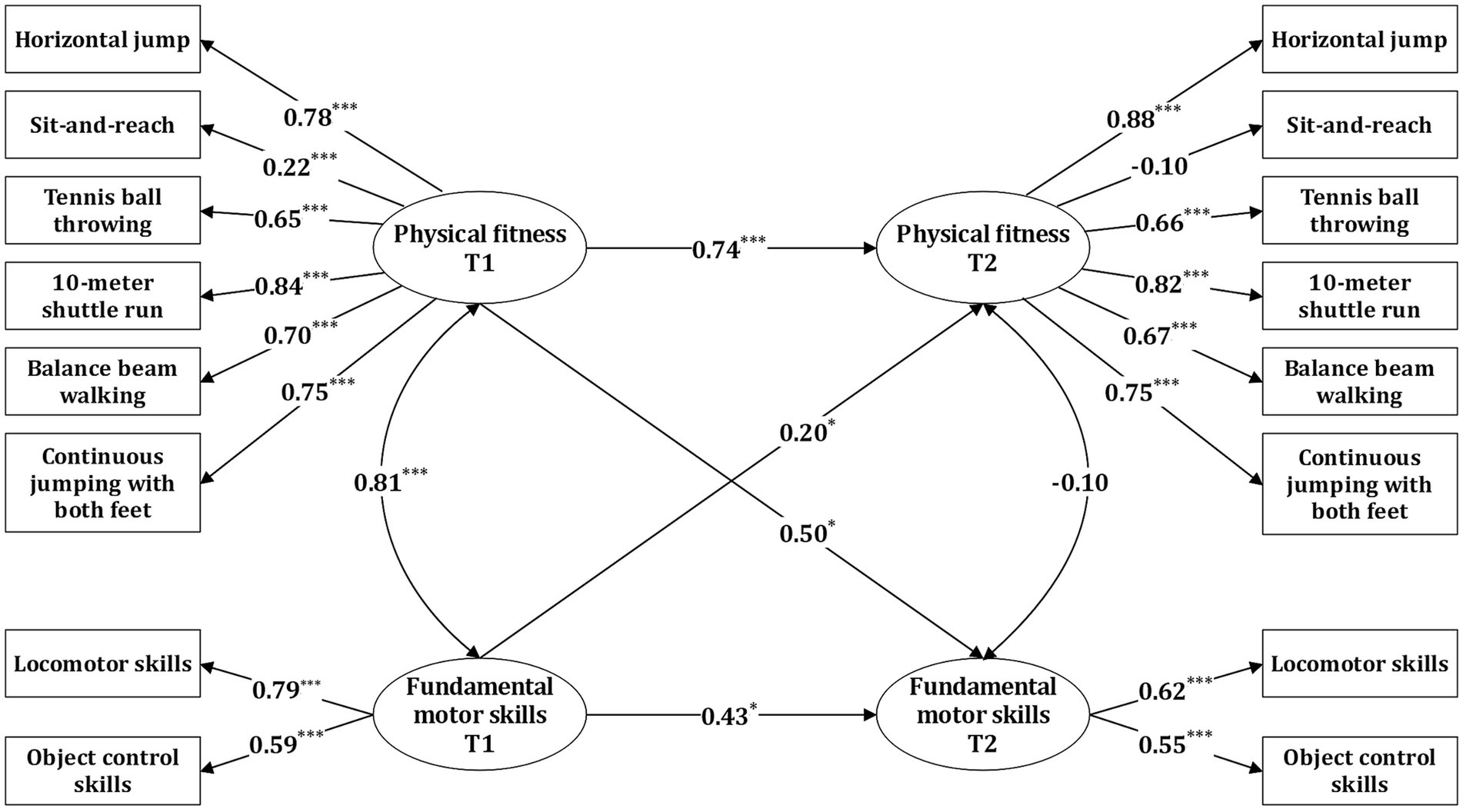- 1Department of Sports Science, Nantong University, Nantong, China
- 2Department of Kinesiology, Beijing Sport University, Beijing, China
Purpose: Physical fitness and fundamental motor skills are two important aspects for the healthy development of preschoolers. Despite the growing interest in clarifying their relationship, the scarcity of longitudinal studies prevents us from understanding causality.
Method: This study employed a cross-lagged model with two time points to investigate the bidirectional relationship between these two aspects. A total of 174 preschoolers (54.0% girls) from 3 to 6 years old (M = 3.96 ± 0.47) were surveyed, they were recruited by convenience from two kindergartens in Beijing, China, and their physical fitness (via CNPFDSM-EC) and fundamental motor skills (via TGMD-3) were tracked over a period of 6 months.
Results: The findings revealed a bidirectional predictive effect. The predictive strength of flexibility was found to be lower than other physical fitness aspects, while locomotor skills demonstrated a higher predictive strength than object control skills.
Conclusion: This study indicates that physical fitness and fundamental motor skills mutually enhance each other in young children, and both should be emphasized in preschool sports education.
1. Introduction
Fundamental motor skills and physical fitness are crucial factors in fostering positive trajectories of health over time. Fundamental motor skills refer to basic, non-naturally occurring, and learnable movement patterns (Haywood and Getchell, 2014). In early life, mastering a broad range of these skills is beneficial for future learning of more complex motor skills, active and continuous participation in various sports, and the development of a lifelong exercise habit (Henrique et al., 2016). Furthermore, during this developmental period, fundamental motor skills are positively correlated with children’s physical activity, healthy weight status, and even their academic performance (Robinson et al., 2015; Engel et al., 2018; de Waal, 2019). Physical fitness refers to an individual’s capacity to undertake physical activity. Its components include cardiorespiratory fitness, muscular strength, speed-agility and flexibility (Caspersen et al., 1985), and it is a health and well-being indicator even from a young age (Ortega et al., 2008). Moreover, physical fitness is thought to have a positive effect on a range of psychological indicators, such as cognition, depression, and self-esteem (Cadenas-Sanchez et al., 2021).
Fundamental motor skills and physical fitness are correlated in early childhood (Utesch et al., 2019). The conceptual framework presented by Stodden (2008) explains that the acquisition of motor skill competence in fundamental motor skills in early childhood (2–5 years of age) serves to enhance physical fitness. As the child ages, this relationship evolves into a bidirectional one in mid to late childhood. Similarly, Hulteen et al. (2018) propose a model that delineates the progression of motor skills over time. This model illustrates that skill development can either be hindered or enhanced by physical and psychological factors such as physical fitness and perceived competence. Both models emphasize the importance of understanding the development of fundamental motor skills and physical fitness, as well as their influence on each other.
Although both models hypothesize a relationship between fundamental motor skills and physical fitness during early childhood, the current research evidence is quite limited. This is supported by the results of a meta-analysis, which underscores the lack of studies investigating the relationship between fundamental motor skills and physical fitness in children younger than 7–8 years of age (Utesch et al., 2019). Only two cross-sectional studies have explored the correlation between these two aspects among preschoolers. Frith and Loprinzi (2019) demonstrated a positive correlation between motor skills and musculoskeletal endurance (measured via the plank test), and Wang et al. (2019) supported a low to moderate positive association between fundamental motor skills and physical fitness. However, due to the cross-sectional nature of these studies, it’s impossible to determine causality in their co-development. Longitudinal studies provide the potential to uncover their dynamic and reciprocal relationship. This capability will assist researchers and practitioners in understanding how to stimulate and nurture physical fitness and motor competence more effectively. The ultimate goal is to improve health outcomes and promote lifelong physical activity.
Thus, the goal of this study is to employ a longitudinal study design, comprising two time points, to explore the relationship between physical fitness and fundamental motor skills through a cross-lagged model, after controlling for confounding factors such as age, gender and BMI. Our hypothesis is that the relationship between these two aspects at the preschool age is bidirectional and mutually reinforcing.
2. Materials and methods
2.1. Participants
An observational longitudinal design was used to study 174 typically developed children (54.0% girls) from 3 to 6 years old (M = 3.96 ± 0.47) at baseline. Participants were recruited by convenience from two kindergartens in Beijing, China. Data were collected two time points, the baseline test (T1) was conducted from November to December 2020, and the follow-up test (T2) was conducted at a 6-month interval, from May to June 2021. A total of 212 children participated in T1, and 174 participated in T2 (the lower number being a result of absences, illnesses and transfers), with an attrition rate of 17.5%. Analysis of the attrition sample, chi-square and t-test results suggested no significant difference between children who continued to participate in the study and those who did not, in terms of gender (χ2 = 2.71, p = 0.23); age (t = 0.97, p = 0.45) and aspects of physical fitness and fundamental motor skills (p > 0.05). This indicated random attrition. Parents of all participants signed the Parental Informed Consent Form to indicate their consent to participate in the study.
2.2. Instruments
Fundamental motor skills were assessed using the third edition of the Test of Gross Motor Development (TGMD-3), a process-oriented test that contains locomotor and object control subtests (Ulrich, 2013) The former subtest comprised 6 skills: running, horizontal jump, hop, gallop, slide, and skip; and the latter 7: two-handed strike of a stationary ball, forehand strike of self-bounced ball, one hand stationary dribble, overhand throw, underhand throw, two-handed catch, and kicking a stationary ball. Each skill in TGMD-3 was tested twice and scored according to 3 to 5 criteria, with 1 point for meeting one criterion and 0 points for meeting none. The original score was 46 for locomotor skills, 54 for object control motor skills, and 100 for total score. This scale has acceptable internal consistency and test–retest reliability for Chinese children (Ning et al., 2016a; Diao et al., 2018).
Physical fitness was assessed using the early childhood section of the China National Physical Fitness Determination Standard Manual(CNPFDSM-EC), formulated by the State General Administration of Sports (Zhang et al., 2017). The test comprised 6 items: 10-meter shuttle run, horizontal jump, tennis ball throwing, continuous jumping with both feet, sit-and-reach, and balance beam walking. All items were measured twice, and the best score taken. In addition to physical fitness, the height and weight of the preschoolers were measured, and the Body Mass Index (BMI = weight/[height2]) was calculated. The classification of overweight and obese used in this study is based on the BMI criteria established by the International Obesity Working Group (Cole, 2000).
2.3. Procedure
All tests were conducted in the playgrounds of the respective schools and lasted approximately 30–45 min per child.
Tests of fundamental motor skills were performed by two trained research assistants, one of whom was responsible for demonstrating and testing, and the other for recording the preschoolers’ performances using a video camera. The testing protocol began with a single demonstration by the research assistant, followed by one practice trial. If the child’s performance during the trial was deemed incorrect, an additional demonstration was provided. Subsequently, two formal tests were administered. After the test, a trained observer assessed the child’s performance via video. The observer had a previously established 93% interrater agreement with a trained researcher.
Physical fitness, height and weight tests were administered by three additional trained research assistants. Each assistant had a distinct role: one conducted the tests, another ensured the children’s safety, and the third recorded the test results. To ensure both testing efficiency and adherence to the principles of static and dynamic performance during the testing process, a sequence was established: balance beam walking, 10-meter shuttle run, standing long jump, tennis ball throwing, continuous jumping with both feet, sit-and-reach. The final measurements were height and weight.
2.4. Statistical analyses
First, descriptive statistics were obtained for each variable, and the age and gender characteristics of BMI, physical fitness and fundamental motor skills were presented by a two-way analysis of variance (two-way ANOVA), with the changes in the development of each variable over time presented in a paired t-test. Second, to examine the correlation between BMI, physical fitness and fundamental motor skills at two time points, correlation indexes were calculated through Pearson’s correlation coefficient. Finally, cross-lagged models were used, controlling for variables such as age, gender and BMI, to further confirm the chronological order and causality between physical fitness and fundamental motor skills.
The two-way ANOVA, paired t-test and correlation analysis were performed in SPSS 18.0, and the cross-lagged model test in Mplus 8.3. The fit index and acceptable critical values used for the cross-lagged model assessment were χ2, df (χ2 / df < 2), CFI (> 0.90), TLI (> 0.90), RMSEA (< 0.08), and SRMR (< 0.08), respectively, as used in previous studies (Hu and Bentler, 1999).
3. Results
3.1. Descriptive data and correlations
Before examining the cross-lagged model, we tested the descriptive data and correlation matrix. The results of the two-way ANOVA showed that the main effects of age and gender were significant in both T1 and T2, but there was no interaction between the variables (see Table 1). For this reason, only the separate effects of age and gender will be analyzed.
At T1, the main effects of age on BMI and sit-and-reach were not significant, while the remaining indicators of physical fitness and fundamental motor skills had a significant main effect and increased with age. The main effect of gender was significant only in tennis ball throwing and object control skills, where boys scored significantly higher (F = 23.121, p < 0.001, ηp2 = 0.171; and F = 11.181, p < 0.001, ηp2 = 0.134 respectively) (see Table 2). At T2, the main effects of age on BMI and object control skills were not significant, the remaining indicators also increased with age, with a significant main effect. The main effect of gender was significant only in tennis ball throwing, object control skills and sit-and-reach. In the former two, boys scored significantly higher (F = 16.690, p < 0.001, ηp2 = 0.152; and F = 16.064, p < 0.001, ηp2 = 0.147 respectively), but had lower scores in sit-and-reach (F = 11.181, p = 0.001, ηp2 = 0.134) (see Table 3). The 6-month follow-up data suggested that the BMI of participants did not change over time (t = 1.109, p = 0.270), while the other indicators improved significantly (see Table 4).
As can be seen from the results of the correlation matrix, BMI was not significantly correlated with either fundamental motor skills or physical fitness. The correlation between sit-and-reach and fundamental motor skills was weak, and the rest of the physical fitness were significantly correlated with fundamental motor skills (see Table 5).
3.2. Cross-lagged model results
On the basis of the correlation analysis, the cross-lagged model was used to explore the longitudinal relationship between physical fitness and fundamental motor skills. The results showed that age and gender had significant effects on both, while BMI did not. As a result, only age and gender were included as control variables in the model. The model had a good degree of fit: χ2 = 120.73, df = 84, χ2/df = 1.44, p > 0.05, RMSEA = 0.067, CFI = 0.951, TLI = 0.931, SRMR = 0.049.
Figure 1 showed that T1 physical fitness effectively predicted T2 physical fitness (β = 0.74, SE = 0.086, p < 0.001), and similarly, T1 fundamental motor skills effectively predicted T2 fundamental motor skills (β = 0.43, SE = 0.212, p = 0.043), In terms of the β coefficient, physical fitness has greater stability compared to fundamental motor skills. After controlling for the effects of age, gender, and autoregressive effects, T1 fundamental motor skills effectively predicted T2 physical fitness (β = 0.20, SE = 0.094, p = 0.034). Among the two dimensions of fundamental motor skills, the factor loadings for locomotor skills were higher than those for object control skills. Furthermore, T1 physical fitness also effectively predicted T2 fundamental motor skills (β = 0.50, SE = 0.212, p = 0.017). In physical fitness, the factor loadings of sit-and-reach were lower than those of the other dimensions.
4. Discussion
This study used a cross-lagged model to investigate the bidirectional relationship between physical fitness and fundamental motor skills in preschoolers. In doing so, it compensated for the shortcomings of previous cross-sectional studies that could determine the magnitude but not the direction of the association, and provided new evidence for the relationship. The findings support our proposed research hypothesis that preschoolers’ fundamental motor skill levels could predict physical fitness (and vice versa) 6 months later.
To control the extraneous variables in the subsequent cross-lagged model, this study first examined the demographic variables of age, gender, and BMI. The results showed that age and gender had a significant effect on physical fitness and fundamental motor skills, while BMI did not. When cross-sectional and longitudinal data were combined, all indicators except BMI increased with age, which is consistent with previous studies (Yang et al., 2015; Ning et al., 2016b; Tu et al., 2021), and with the growth and development patterns of preschoolers. Boys outperformed girls in both object control skills and tennis ball throwing, whereas girls excelled in sit-and-reach. The TGMD-3 also found gender differences in fundamental motor skills when establishing regional norms in the United States (Ulrich, 2019) and Shanghai, China (Diao et al., 2018), thereby setting separate object control skill norms for boys and girls. Previous studies suggest that such gender differences are not biological (Goodway et al., 2021) but are associated with family, environmental, and sociocultural factors (Krombholz, 2006; Spessato et al., 2012; Iivonen and Sääkslahti, 2014). For example: parents tend to encourage boys to participate in ball games, and girls in sports related to gymnastics, dance, or role-play. As a result, boys and girls have different sporting experiences that cause them to perform differently in tennis ball throwing and sit-and-reach. The analysis in this study revealed no association between BMI and either physical fitness or fundamental motor skills. This contradicts previous studies that found a negative relationship between BMI and fundamental motor skills, particularly locomotor skills (Southall et al., 2004; Zhou, 2020). This is because preschoolers need to overcome gravity to coordinate their body movements; overweight and obese children find this more challenging, resulting in lower locomotor skills scores. A Chinese study that investigated the effect of weight on the physical fitness of children aged 5–6 found that the group with normal body weight had a higher level of physical fitness than the under-and overweight groups (Xu et al., 2015). The small number of overweight and obese children in this study’s sample (only 5%) may explain why BMI did not correlate with other indicators.
The cross-lagged results for fundamental motor skills and physical fitness in preschoolers revealed that T1 fundamental motor skills effectively predicted T2 physical fitness. This aligns with several previous longitudinal studies, which found that proficient fundamental motor skills in early childhood had a positive effect on future physical development, including cardiopulmonary endurance, and muscle endurance and strength (Hands, 2008; Fransen et al., 2014; Vlahov et al., 2014; Lima et al., 2019). Fransen et al. (2014) investigated fundamental motor skills, physical fitness and participation in physical activity among 6-year-olds in a two-year follow-up study, and found that children with low levels of movement rarely participated in physical activities. This resulted in a lack of opportunity to develop their fundamental motor skills and physical fitness, which in turn prevented them from catching up with their more active peers. Most of the studies discussed primarily examined the effects of locomotor and stability skills on physical fitness. Our study found further proof of the important role of object control skills in the development of physical fitness. Although the factor loadings for object control skills (0.59) were lower than those for locomotor skills (0.79), this might be related to the composition of the physical fitness test items and the short follow-up period. It does not imply that object control skills are less important than locomotor skills. Vlahov et al. (2014) found in their 11-year follow-up study that object control skills in preschoolers were more predictive of physical fitness in high school than locomotor skills. Despite our study’s shorter follow-up period (6 months), it provides evidence that fundamental motor skills are equally predictive of physical fitness in the short term.
The study also discovered that T1 physical fitness effectively predicted T2 fundamental motor skills, which does not support Stodden’s hypothesis of a unidirectional relationship between physical fitness and fundamental motor skills in early childhood (Stodden, 2008). Two longitudinal studies also found that the performance of 6-year-old children in grip, horizontal jump, and the 1-mile walk could predict fundamental motor skills at age 9 (dos Santos et al., 2018; Henrique et al., 2018). Wang et al. (2019) demonstrated that physical fitness explained 15–16 percent of motor skill variance. All these studies provide evidence of a bidirectional relationship between fundamental motor skills and physical fitness. Among the six physical fitness in this study, the factor loadings for flexibility, measured by sit-and-reach, were substantially lower than those of other fitness. This result aligns with previous studies, Coppens et al. (2019) found that flexibility in 8-year-old children did not predict fundamental motor skill levels two years later. Although flexibility is structurally less correlated with motor skills from a theoretical perspective, its actual impact needs to be confirmed by further studies, as current research is limited. Cattuzzo et al. (2016) highlighted that the interrelationship between fundamental motor skills and physical fitness is closely related, as both require substantial neuromuscular control to achieve efficient and coordinated motor performance. Furthermore, the two are related both directly, through neuromuscular function, and indirectly, through participation in physical activities. Therefore, Fundamental motor skills and physical fitness mutually enhance each other in early childhood, and both should be the focus of sports promotion in preschools.
4.1. Research limitations and prospects
This study contained some limitations that should be addressed in future research. Firstly, it utilized a limited number of variables; similar studies usually include a cardiorespiratory test, such as the 20-meter shuttle run, when measuring physical fitness in preschoolers. Additionally, fundamental motor skills include stability skills in addition to locomotor and object control (Barnett et al., 2016). Future studies are recommended to include more variables to explore the role of stability skills and their impact on physical fitness. In addition, sample size is considered important in longitudinal studies. To ensure acceptable attrition rates and account for the rapid growth and development during preschool years, this study used a six-month follow-up interval. However, it was not determined whether this interval was optimal for observing the developmental patterns of both variables. To more comprehensively reveal the developmental trends of the variables and the patterns of the relationships between them, future studies could obtain more accurate relationships between the development of physical fitness and fundamental motor skills in preschoolers by expanding the sample size and extending the duration and number of follow-ups.
4.2. Practical applications
Educators should take a balanced view when evaluating the role of fundamental motor skills in pre-school physical education. This study indicates a bidirectional predictive relationship between fundamental motor skills and physical fitness; in fact, physical fitness plays an even stronger predictive role in the development of fundamental motor skills. This two-way relationship contrasts with older perspectives, notably the Stodden’s theoretical model, which posited fundamental motor skills as the sole basis for physical fitness in preschoolers. Relying solely on such a model can result in an imbalanced curriculum that overemphasizes motor skills, hindering well-rounded development in young children.
Moreover, educators should continuously expand their understanding of both fundamental motor skills and physical fitness for preschoolers. Initial surveys from this study revealed that kindergarten teachers in China often have a narrow view, associating fundamental motor skills mainly with actions like “walking, running, jumping, throwing, crawling, climbing, and scaling.” This focus predominantly on locomotor skills overlooks the comprehensive framework of fundamental motor skills, which includes three key dimensions: locomotor, object control, and stability (Barnett et al., 2016). Additionally, in terms of physical fitness, strength, speed, and endurance should not be the focus for preschoolers who lack the necessary physical foundation; instead, attributes related to rapid neurological development such as agility, balance, and coordination should be emphasized (Istvan et al., 2013).
5. Conclusion
Physical fitness and fundamental motor skills have been found to exhibit a bidirectional predictive effect in preschoolers. Flexibility, compared to other forms of physical fitness, shows a weaker prediction, while locomotor skills predict more effectively than object control skills. This study provides new evidence for Stodden’s theoretical model, and underscoring the importance of simultaneous learning of physical fitness and fundamental motor skills during preschool years to foster the health and development of young children.
Data availability statement
The original contributions presented in the study are included in the article/supplementary material, further inquiries can be directed to the corresponding author.
Ethics statement
The studies involving humans were approved by Ethics Committee of Nantong University. The studies were conducted in accordance with the local legislation and institutional requirements. Written informed consent for participation in this study was provided by the participants’ legal guardians/next of kin.
Author contributions
JC: Writing – original draft. WS: Writing – review & editing, Methodology. XZ: Writing – review & editing. HL: Writing – review & editing. DL: Writing – review & editing.
Funding
The author(s) declare that no financial support was received for the research, authorship, and/or publication of this article.
Acknowledgments
The authors would like to express their gratitude to EditSprings (https://www.editsprings.cn) for the expert linguistic services provided.
Conflict of interest
The authors declare that the research was conducted in the absence of any commercial or financial relationships that could be construed as a potential conflict of interest.
Publisher’s note
All claims expressed in this article are solely those of the authors and do not necessarily represent those of their affiliated organizations, or those of the publisher, the editors and the reviewers. Any product that may be evaluated in this article, or claim that may be made by its manufacturer, is not guaranteed or endorsed by the publisher.
References
Barnett, L. M., Stodden, D., Cohen, K. E., Smith, J. J., Lubans, D. R., Lenoir, M., et al. (2016). Fundamental movement skills: an important focus. J. Teach. Phys. Educ. 35, 219–225. doi: 10.1123/jtpe.2014-0209
Cadenas-Sanchez, C., Mena-Molina, A., Torres-Lopez, L. V., Migueles, J. H., Rodriguez-Ayllon, M., Lubans, D. R., et al. (2021). Healthier minds in fitter bodies: a systematic review and Meta-analysis of the association between physical fitness and mental health in youth. Sports Med. 51, 2571–2605. doi: 10.1007/s40279-021-01520-y
Caspersen, C. J., Powell, K. E., and Christenson, G. M. (1985). Physical activity, exercise, and physical fitness: definitions and distinctions for health-related research. Public Health Rep. 100, 126–131. doi: 10.2307/20056429
Cattuzzo, M. T., Henrique, R. D., Re, A. H. N., de Oliveira, I. S., Melo, B. M., Moura, M. D., et al. (2016). Motor competence and health related physical fitness in youth: a systematic review. J. Sci. Med. Sport 19, 123–129. doi: 10.1016/j.jsams.2014.12.004
Cole, T. J. (2000). Establishing a standard definition for child overweight and obesity worldwide: international survey. BMJ 320, 1240–1243. doi: 10.1136/bmj.320.7244.1240
Coppens, E., Bardid, F., Deconinck, F. J. A., Haerens, L., Stodden, D., D’Hondt, E., et al. (2019). Developmental change in motor competence: a latent growth curve analysis. Front. Physiol. 10, 1–10. doi: 10.3389/fphys.2019.01273
de Waal, E. (2019). Fundamental movement skills and academic performance of 5-to 6-year-old preschoolers. Early Childhood Educ. J. 47, 455–464. doi: 10.1007/s10643-019-00936-6
Diao, Y. C., Dong, C. X., and Li, J. (2018). The establishment of norm of gross motor development test in Shanghai. China Sport Sci. Technol. 54, 98–104. doi: 10.16470/j.csst.201802013
dos Santos, M. A. M., Nevill, A. M., Buranarugsa, R., Pereira, S., Gomes, T., Reyes, A., et al. (2018). Modeling children’s development in gross motor coordination reveals key modifiable determinants. An allometric approach. Scand. J. Med. Sci. Sports 28, 1594–1603. doi: 10.1111/sms.13061
Engel, A. C., Broderick, C. R., van Doorn, N., Hardy, L. L., and Parmenter, B. J. (2018). Exploring the relationship between fundamental motor skill interventions and physical activity levels in children: a systematic review and Meta-analysis. Sports Med. 48, 1845–1857. doi: 10.1007/s40279-018-0923-3
Fransen, J., Deprez, D., Pion, J., Tallir, I. B., D’Hondt, E., Vaeyens, R., et al. (2014). Changes in physical fitness and sports participation among children with different levels of motor competence: a 2-year longitudinal study. Pediatr. Exerc. Sci. 26, 11–21. doi: 10.1123/pes.2013-0005
Frith, E., and Loprinzi, P. D. (2019). Association between motor skills and musculoskeletal physical fitness among preschoolers. Matern. Child Health J. 23, 1003–1007. doi: 10.1007/s10995-019-02753-0
Goodway, J. D., Gallahue, D. L., and Ozmun, J. C. (2021). Understanding motor development: Infants, children, adolescents, adults. Burlington: Jones & Bartlett Learning.
Hands, B. (2008). Changes in motor skill and fitness measures among children with high and low motor competence: a five-year longitudinal study. J. Sci. Med. Sport 11, 155–162. doi: 10.1016/j.jsams.2007.02.012
Haywood, K. M., and Getchell, N. (2014). Life span motor development. United States: Huamn Kinetics.
Henrique, R. S., Bustamante, A. V., Freitas, D. L., Tani, G., Katzmarzyk, P. T., and Maia, J. A. (2018). Tracking of gross motor coordination in Portuguese children. J. Sports Sci. 36, 220–228. doi: 10.1080/02640414.2017.1297534
Henrique, R. S., Re, A. H. N., Stodden, D. F., Fransen, J., Campos, C. M. C., Queiroz, D. R., et al. (2016). Association between sports participation, motor competence and weight status: a longitudinal study. J. Sci. Med. Sport 19, 825–829. doi: 10.1016/j.jsams.2015.12.512
Hu, L. T., and Bentler, P. M. (1999). Cutoff criteria for fit indexes in covariance structure analysis: conventional criteria versus new alternatives. Struct. Equ. Model. 6, 1–55. doi: 10.1080/10705519909540118
Hulteen, R. M., Morgan, P. J., Barnett, L. M., Stodden, D. F., and Lubans, D. R. (2018). Development of foundational movement skills: a conceptual model for physical activity across the lifespan. Sports Med. 48, 1533–1540. doi: 10.1007/s40279-018-0892-6
Iivonen, S., and Sääkslahti, A. K. (2014). Preschool children’s fundamental motor skills: a review of significant determinants. Early Child Dev. Care 184, 1107–1126. doi: 10.1080/03004430.2013.837897
Istvan, B., Colin, H., and Richard, W. (2013). Long-term athlete development. Champaign, IL: Human Kinetics.
Krombholz, H. (2006). Physical performance in relation to age, sex, birth order, social class, and sports activities of preschool children. Percept. Mot. Skills 102, 477–484. doi: 10.2466/pms.102.2.477-484
Lima, R. A., Bugge, A., Ersboll, A. K., Stodden, D. F., and Andersen, L. B. (2019). The longitudinal relationship between motor competence and measures of fatness and fitness from childhood into adolescence. J. Pediatr. 95, 482–488. doi: 10.1016/j.jped.2018.02.010
Ning, K., Shen, X. S., and Shao, X. J. (2016a). The relationship between locomotor development and perceived physical competence in children aged 3-6 years: an empirical study. J. Beijing Sport Univ. 39, 74–81. doi: 10.19582/j.cnki.11-3785/g8.2016.12.012
Ning, K., Shen, X. S., and Shao, X. J. (2016b). Research on the age and gender characteristics of the development of gross motor in preschool children. Chinese J. Child Health Care 24, 1322–1325. doi: 10.11852/zgetbjzz2016-24-12-27
Ortega, F. B., Ruiz, J. R., Castillo, M. J., and Sjostrom, M. (2008). Physical fitness in childhood and adolescence: a powerful marker of health. Int. J. Obes. 32, 1–11. doi: 10.1038/sj.ijo.0803774
Robinson, L. E., Stodden, D. F., Barnett, L. M., Lopes, V. P., Logan, S. W., Rodrigues, L. P., et al. (2015). Motor competence and its effect on positive developmental trajectories of health. Sports Med. 45, 1273–1284. doi: 10.1007/s40279-015-0351-6
Southall, J. E., Okely, A. D., and Steele, J. R. (2004). Actual and perceived physical competence in overweight and nonoverweight children. Pediatr. Exerc. Sci. 16, 15–24. doi: 10.1123/pes.16.1.15
Spessato, B., Gabbard, C., Valentini, N., and Rudisill, M. (2012). Gender differences in Brazilian Children’s fundamental movement skill development. Early Child Dev. Care 183, 916–923. doi: 10.1080/03004430.2012.689761
Stodden, D. F. (2008). A developmental perspective on the role of motor skill competence in physical activity: an emergent relationship. Quest 60, 290–306. doi: 10.1080/07303084.2007.10598077
Tu, C. J., Zhang, Y. F., Wu, D. M., Zhang, S. H., and Jiang, C. M. (2021). Construction BMI percentile standard curve and cut-off points for overweight and obesity of 3~6 years children based on GAMLSS model in China. China Sport Sci. 41, 63–73. doi: 10.16469/j.css.202103008
Ulrich, D. A. (2013). The test of gross motor development-3 (TGMD-3): administration, scoring, and international norms. Hacettepe J. Sport Sci. 24, 27–33.
Ulrich, D. A. (2019). The test of gross motor development-3 (tgmd-3): Examiner’s manual. Austin: Pro-ed.
Utesch, T., Bardid, F., Busch, D., and Strauss, B. (2019). The relationship between motor competence and physical fitness from early childhood to early adulthood: a Meta-analysis. Sports Med. 49, 541–551. doi: 10.1007/s40279-019-01068-y
Vlahov, E., Baghurst, T. M., and Mwavita, M. (2014). Preschool motor development predicting high school health-related physical fitness: a prospective study. Percept. Mot. Skills 119, 279–291. doi: 10.2466/10.25.PMS.119c16z8
Wang, H., Hu, S. Q., Li, Y. C., and Zheng, Y. D. (2019). Canonical correlation of motor skills and physical fitness in preschool children. China Sport Sci. Technol. 55, 46–51. doi: 10.16470/j.csst.2019018
Xu, L. L., Liu, X., and Wang, M. (2015). Effect of underweight and overweight on children’s physical fitness. China Sport Sci. Technol. 51, 127–131. doi: 10.16470/j.csst.2015.01.015
Yang, S.-C., Lin, S.-J., and Tsai, C.-Y. (2015). Effect of sex, age, and bmi on the development of locomotor skills and object control skills among preschool children. Percept. Mot. Skills 121, 873–888. doi: 10.2466/10.PMS.121c29x0
Zhang, Y. H., He, Z. T., and Xu, J. H. (2017). National Physical Fitness Surveillance and evaluation. BeiJing: Science Press.
Keywords: fundamental motor skills, physical fitness, preschoolers, longitudinal data, cross-lagged model
Citation: Chen J, Song W, Zhao X, Lou H and Luo D (2023) The relationship between fundamental motor skills and physical fitness in preschoolers: a short-term longitudinal study. Front. Psychol. 14:1270888. doi: 10.3389/fpsyg.2023.1270888
Edited by:
Manuel Gómez-López, University of Murcia, SpainReviewed by:
Pedro Gil-Madrona, University of Castilla-La Mancha, SpainLuís Branquinho, Higher Institute of Educational Sciences of the Douro, Portugal
Copyright © 2023 Chen, Song, Zhao, Lou and Luo. This is an open-access article distributed under the terms of the Creative Commons Attribution License (CC BY). The use, distribution or reproduction in other forums is permitted, provided the original author(s) and the copyright owner(s) are credited and that the original publication in this journal is cited, in accordance with accepted academic practice. No use, distribution or reproduction is permitted which does not comply with these terms.
*Correspondence: Dongmei Luo, MjAyMzA1OEBudHUuZWR1LmNu
 Jiebo Chen
Jiebo Chen Wenjing Song2
Wenjing Song2 Xing Zhao
Xing Zhao Hu Lou
Hu Lou